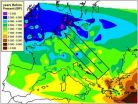(Press-News.org) Surprising new evidence which overturns current theories of how humans colonised the Pacific has been discovered by scientists at the University of Leeds, UK.
The islands of Polynesia were first inhabited around 3,000 years ago, but where these people came from has long been a hot topic of debate amongst scientists. The most commonly accepted view, based on archaeological and linguistic evidence as well as genetic studies, is that Pacific islanders were the latter part of a migration south and eastwards from Taiwan which began around 4,000 years ago.
But the Leeds research – published today in The American Journal of Human Genetics – has found that the link to Taiwan does not stand up to scrutiny. In fact, the DNA of current Polynesians can be traced back to migrants from the Asian mainland who had already settled in islands close to New Guinea some 6-8,000 years ago.
The type of DNA extracted and analysed in this kind of study is that stored in the cell's mitochondria. Mitochondrial DNA (mtDNA) is passed down the maternal line, providing a record of inheritance which goes back thousands of years. The scientists look for genetic signatures which enable them to classify the DNA into different lineages and then use a 'molecular clock' to date when these lineages moved into different parts of the world.
Lead researcher, Professor Martin Richards, explains: "Most previous studies looked at a small piece of mtDNA, but for this research we studied 157 complete mitochondrial genomes in addition to smaller samples from over 4,750 people from across Southeast Asia and Polynesia. We also reworked our dating techniques to significantly reduce the margin of error. This means we can be confident that the Polynesian population – at least on the female side – came from people who arrived in the Bismarck Archipelago of Papua New Guinea thousands of years before the supposed migration from Taiwan took place."
Nevertheless, most linguists maintain that the Polynesian languages are part of the Austronesian language family which originates in Taiwan. And most archaeologists see evidence for a Southeast Asian influence on the appearance of the Lapita culture in the Bismarck Archipelago around 3,500 years ago. Characterised by distinctive dentate stamped ceramics and obsidian tools, Lapita is also a marker for the earliest settlers of Polynesia.
Professor Richards and co-researcher Dr Pedro Soares (now at the University of Porto), argue that the linguistic and cultural connections are due to smaller migratory movements from Taiwan that did not leave any substantial genetic impact on the pre-existing population.
"Although our results throw out the likelihood of any maternal ancestry in Taiwan for the Polynesians, they don't preclude the possibility of a Taiwanese linguistic or cultural influence on the Bismarck Archipelago at that time," explains Professor Richards. "In fact, some minor mitochondrial lineages back up this idea. It seems likely there was a 'voyaging corridor' between the islands of Southeast Asia and the Bismarck Archipelago carrying maritime traders who brought their language and artefacts and perhaps helped to create the impetus for the migration into the Pacific.
"Our study of the mtDNA evidence shows the interactions between the islands of Southeast Asia and the Pacific was far more complex than previous accounts tended to suggest and it paves the way for new theories of the spread of Austronesian languages."
INFORMATION:
The study, which involved researchers from the UK, Taiwan and Australia, was mainly funded by the British Academy, the Bradshaw Foundation and the European Union.
END
New research shows that the 2010 Amazon drought may have been even more devastating to the region's rainforests than the unusual 2005 drought, which was previously billed as a one-in-100 year event.
Analyses of rainfall across 5.3 million square kilometres of Amazonia during the 2010 dry season, published tomorrow in Science, shows that the drought was more widespread and severe than in 2005. The UK-Brazilian team also calculate that the carbon impact of the 2010 drought may eventually exceed the 5 billion tonnes of CO2 released following the 2005 event, as severe droughts ...
WALNUT CREEK, Calif.—A tiny crustacean that has been used for decades to develop and monitor environmental regulations is the first of its kind to have its genetic code sequenced and analyzed—revealing the most gene-packed animal characterized to date. The information deciphered could help researchers develop and conduct real-time monitoring systems of the effects of environmental remediation efforts.
Considered a keystone species in freshwater ecosystems, the waterflea, Daphnia pulex, is roughly the size of the equal sign on a keyboard. Its 200 million-base genome was ...
La Jolla, CA, February 2, 2011 – Embargoed by the journal Science until February 3, 2011, 2 PM, Eastern time - A team of scientists at The Scripps Research Institute has discovered a new way to stabilize proteins — the workhorse biological macromolecules found in all organisms. Proteins serve as the functional basis of many types of biologic drugs used to treat everything from arthritis, anemia, and diabetes to cancer.
As described in the February 4, 2011 edition of the journal Science, when the team attached a specific oligomeric array of sugars called a "glycan" to ...
In a discovery that may lead to a new treatment for breast cancer that has spread to the bone, a Princeton University research team has unraveled a mystery about how these tumors take root.
Cancer cells often travel throughout the body and cause new tumors in individuals with advanced breast cancer -- a process called metastasis -- commonly resulting in malignant bone tumors. What the Princeton research has uncovered is the exact mechanism that lets the traveling tumor cells disrupt normal bone growth. By zeroing in on the molecules involved, and particularly a protein ...
Australian scientists have successfully cleared a HIV-like infection from mice by boosting the function of cells vital to the immune response.
A team led by Dr Marc Pellegrini from the Walter and Eliza Hall Institute showed that a cell signaling hormone called interleukin-7 (IL-7) reinvigorates the immune response to chronic viral infection, allowing the host to completely clear virus. Their findings were released in today's edition of the journal Cell.
Dr Pellegrini, from the institute's Infection and Immunity division, said the finding could lead to a cure for chronic ...
The human brain works incredibly fast. However, visual impressions are so complex that their processing takes several hundred milliseconds before they enter our consciousness. Scientists at the Max Planck Institute for Brain Research in Frankfurt am Main have now shown that this delay may vary in length. When the brain possesses some prior information − that is, when it already knows what it is about to see − conscious recognition occurs faster. Until now, neuroscientists assumed that the processes leading up to conscious perception were rather rigid and that ...
One of the most significant socioeconomic changes in the history of humanity took place around 10,000 years ago, when the Near East went from an economy based on hunting and gathering (Mesolithic) to another kind on agriculture (Neolithic). Farmers rapidly entered the Balkan Peninsula and then advanced gradually throughout the rest of Europe.
Various theories have been proposed over recent years to explain this process, and now physicists from the University of Girona (UdG) have for the first time presented a new model to explain how the Neolithic front slowed down as ...
Massive Art Multimedia in Austria and CoSi Elektronik in Germany have a history of collaboration on successful technical projects. A brainstorming session between their developers produced the idea of bringing together many aspects of the modern computing world and applying them specifically to the one group in society that is least likely to already feel those benefits - senior citizens. As with so many projects of this nature, the funding for development was out of reach of two SMEs. By facilitating the funding process EUREKA permitted the development of the project now ...
Conservationists across the United States are racing to discover a solution to White-Nose Syndrome, a disease that is threatening to wipe out bat species across North America. A review published in Conservation Biology reveals that although WNS has already killed one million bats, there are critical knowledge gaps preventing researchers from combating the disease.
WNS is a fatal disease that targets hibernating bats and is believed to be caused by a newly discovered cold-adapted fungus, Geomyces destructans, which infects and invades the living skin of hibernating bats. ...
Using a generic drug to treat hypertension and heart failure, instead of branded medicines from the same class, could save the UK National Health Service (NHS) at least £200 million in 2011 without any real reduction in clinical benefits.
That is the key finding of a systematic review, statistical meta-analysis and cost-effectiveness analysis just published online by IJCP, the International Journal of Clinical Practice.
Researchers from University College London Hospitals NHS Foundation Trust looked at 14 hypertension and heart studies published between 1998 and 2009 ...




